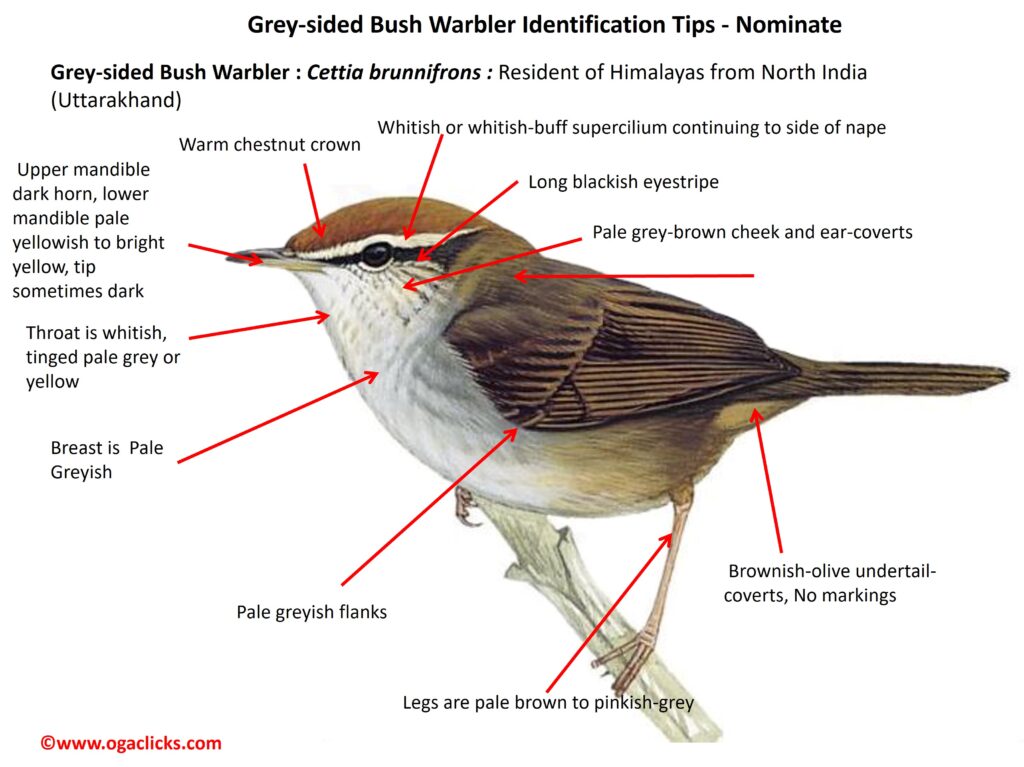
Grey-sided Bush Warbler Cettia brunnifrons
Etymology:
- Cettia : Named after Cetti’s warbler, which itself isnamed after the Italian zoologist Francesco Cetti
- Brunnifrons : Latin word brunneus – brown; frons- forehead,front.
Vernacular Name : Lepcha: Lik-lik-pho
Sub species :
- Nominate- Resident of Himalayas from North India (Uttarakhand)
- b. whistleri– Resident of Kashmir Eastwards to North India (Uttarakhand) {Paler chestnut on head, upperparts and flight-feathers edges and paler undertail-coverts }
- b. umbratica– Resident of North East India (Arunachal Pradesh) {Darker chestnut or rufous-brown on upperparts}
Distribution in India:
- Nominate- Resident of Himalayas from North India (Uttarakhand)
- b. whistleri– Resident of Kashmir Eastwards to North India (Uttarakhand)
- b. umbratica– Resident of North East India (Arunachal Pradesh)
Description: It has a size of 10–11 cm; wt of male 8–9 g, female 6–9 g. It is a small, slender-looking bush-warbler with small bill, long pale supercilium well defined in front of eye. The nominate race has whitish or whitish-buff supercilium continuing to side of nape, long blackish eyestripe, pale grey-brown cheek and ear-coverts. It has a warm chestnut crown and plain brown upperparts. The wings are warmer brown than back. The chin and throat are whitish, becoming pale greyish on breast side and flanks, the rear flanks and undertail-coverts are brownish-olive. The iris are dark; upper mandible is dark horn, lower mandible is pale yellowish to bright yellow, tip are dark. The legs are pale brown to pinkish-grey, variable, sometimes a little darker and slightly purplish. Both the sexes are alike. The juvenile has uniform rufous-brown upperparts, lacks chestnut crown, has supercilium buffish-brown, underparts drab brownish-olive, yellowish-olive on belly. Race whistleri has paler chestnut on head, upperparts and flight-feathers edges and paler undertail-coverts than nominate; umbratica is darker chestnut or rufous-brown on upperparts than nominate.
Habitat: It Breeds in undergrowth and rhododendron shrubberies at edges of evergreen forest and mixed conifer forest, including stunted pines along tree-line, and in clearings, in bamboo and willow thickets, rose bushes , Berberis and gorse patches. It is found between 2300 m –4300 m. In non-breeding season occurs in similar areas, also in tall grasses and bracken on bush-covered hillsides and edges of cultivation , at lower altitudes in foothills, valleys and plains; from 1000 m to 2100 m or lower.
Food habits: It eats small invertebrates, spiders and larvae. It forages on the ground or in low bushes and vegetation. It is shy and secretive, but not so skulking as are other bush-warblers; more likely to be encountered in open especially when singing at start of breeding season.
Breeding habits: They breed in Apr–Aug. The nest is an oval ball or cup-shaped, consisting mostly of grasses, moss, lichens and feathers, placed low down, on the ground, in a bush or in thick vegetation. They lay a clutch of 3–5 eggs